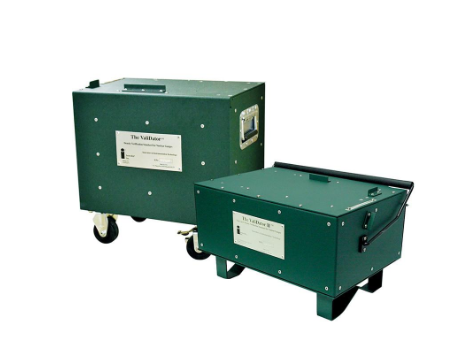Let’s face it, while nuclear gauge calibration technology can be tough to deal with sometimes, it is still by far the best, most accurate and fastest field method to determine soil moisture, density, and compaction. Given that regulations are here to stay many nuclear owners have looked for other areas to help lower the ownership costs, and keep their nuclear gauges in the field where they can make money.
In 1997 InstroTek introduced The ValiDator, a portable block that enables the users to verify the nuclear gauge calibration accuracy of a number of different moisture density gauge models on-site. Currently, the ValiDator is used worldwide by customers in their facilities or at job sites.
Over the last 20 years, the ValiDator calibration verification system has become one of the most popular and trusted calibration and verification systems for nuclear moisture density gauges. The ValiDator meets the verification requirements of AASHTO T310 and calibration/verification requirements of ASTM D6938. The ValiDator and its come with PC software is designed to verify and calibrate CPN MC3 and MC1 DRP, Humboldt 5001 Series, InstroTek 3500 Xplorer, and Troxler 3400 series gauges.
You might be thinking, “This is all well and good, but how is the ValiDator going to save me thousands”? If you take the average calibration costs of $350, the shipping costs to and from the calibration facility plus the downtime of 1-2 weeks for service you could be out of pocket close to $1,000 per gauge each calibration period. Most geotechnical and asphalt companies will own a nuclear gauge on average for 20 years. This means for the life of the gauge you could save close to $20,000 per gauge and with most companies owning 5+ units the number grow very quickly.
There are a number of factors to consider before owning a ValiDator. I am writing this blog to share some of our experiences in implementing the ValiDator system in your organization. This will help avoid any issues during implementation and use of this great quality control device.
Calibration Vs. Service
If your gauge is not maintained according to the manufacturers' recommendations and it requires service, calibrating and/or verifying with the ValiDator will not fix the problem. Have the gauge serviced, before attempting calibration. Service and calibration are two independent functions. Periodic service and maintenance are absolutely necessary, and at a minimum, each gauge must go under routine maintenance steps a minimum of once per year.
Minimum Requirements
Due to the nature and complexity of nuclear gauge calibration, it is imperative that operators be properly certified and trained on the use and maintenance of nuclear gauges. Users with little or no knowledge of this equipment should not be allowed to perform calibration and verification on the ValiDator. The lack of formal training and experience can drastically reduce the quality of measurements. It is also extremely important that operators be properly familiarized and instructed on the use of ValiDator system. Failure to thoroughly read the manual and watch the applications training video could result in equipment failure in the field and costly errors.
ValiDator Manual and Video
Each ValiDator sold includes a manual and instructions video. Proper use and instructions for the ValiDator can be found in the ValiDator manual and by watching the applications training video. We have found that over 90% of all technical support questions and troubleshooting tips can be found by carefully reading the manual and watching the video. A copy of the manual and the video can be found here.
Nuclear Gauge Maintenance Training
InstroTek offers a ½ or full day of training on proper nuclear gauge storage, maintenance, service, and calibration to help reduce your gauge maintenance costs and to ensure proper nuclear gauge calibrations. During this training, a certified InstroTek technician will train the user on proper gauge maintenance methods as well as the application of gauge verification and calibration, using the ValiDator system and VeriFier software. This program has been very successful and customers that have received this training continue saving their organizations money by providing proper maintenance, verification, and calibration of gauges. Furthermore, they better understand the operations of the gauge, which helps with troubleshooting of gauge related matters within their organizations.
If you are still reading, then something has resonated. Maybe it’s lowering calibration costs, or not having to ship your nuclear gauges each year and deal with all the paperwork. Or possibly, you would like to know if you gauges are reading accurately throughout the year. Either way, you are interested. So what’s next? First, gather all the information you have for your nuclear gauges. Information like manufacturer, model, the age of the gauges and the last calibration paperwork is always helpful. Next, call an InstroTek representative to discuss your particular situation and if the ValiDator is the right fit for your organization. Finally, if you decide to purchase the ValiDator, get lots of training. InstroTek is happy to offer extended training to make sure you are well prepared.
The ValiDator is an excellent quality control tool. It can save money, decrease downtime and simplify the calibration process. However, the quality of your verification/calibration is highly dependent on a number of factors like training, experience and correct application of ValiDator procedures. With the support of our experienced technical team, we know you can also have a very successful verification/calibration program at your organization.
Article written by









